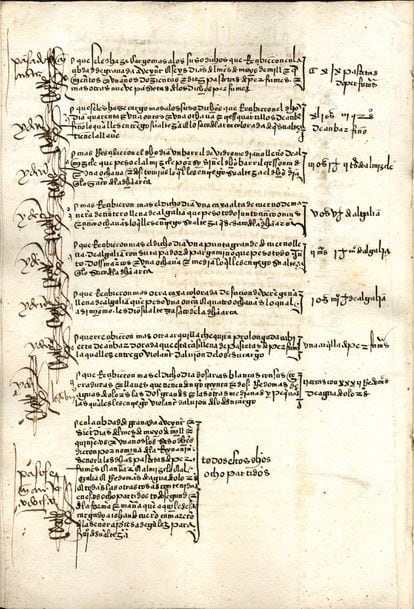Portrait of Isabel la Católica, by anonymous author, which is in the Prado Museum.
The painting was made around 1490, when he already had Sancho Paredes de Guzmán at his service.Heritage Images / Getty Images
Sancho de Paredes Golfín was an extremely meticulous man, with a zeal for his job that led him to write down everything, an official whose work was an exercise in transparency in the Spanish crown.
Sancho served as a waiter for Queen Isabel I of Castile from 1498 until November 1504, when she passed away.
Her work allowed her to access the monarch's offices, of which she wrote down what she had for her private life, and the most intimate, in 10 account books.
"There was already this practice in previous kings in Castile, but the interesting thing is that he left it in writing," says Miguel Ángel Ladero Quesada, from the Academy of History by phone.
"The waiter was the head of the house and was in charge of dozens of people who coordinated," he adds.
More information
'A faustad and unhappy queen'
Relations between Spain and Portugal through art: from Isabel to Isabel
Farewell to your Catholic majesties
The thread that Sancho de Paredes pulled more than 500 years ago did not break.
His notes were passed from generation to generation until the aristocrat Tatiana Pérez de Guzmán el Bueno decided, shortly before dying in 2012, that his immense heritage, including the archive, be passed on to a foundation named after him so that it could become known.
That thread is now wound in the palace of the Golfines de Abajo, in the historic center of Cáceres.
Museum since 2015, the palace also treasures part of the artistic heritage of the foundation.
The walls of this manor house were built in the 15th century by a nobleman, Alonso Golfín, Sancho's father, who had helped the Catholic Monarchs on their way to the crown.
There, a team of documentalists "has been studying, cataloging and digitizing each sheet of the archive for nine years, of which some 2,400 descriptive files, made up of more than 90,000 pages, can be consulted on the foundation's website," explains the person in charge of the archive. , Elisa Arroyo. There are the 10 account books of Sancho de Paredes. In the ninth, bound in leather, he wrote the list of products for perfumes that Isabel la Católica used, such as civet, "an unctuous substance, with a strong smell and acrid taste," he explained. Or musk, "a strong smell secreted by the male of the musk deer, used as base notes in perfumery." To hydrate her face, the queen turned to benzoin, "a resin from a tree from the tropical forests of Southeast Asia." On the dressing table there were also “elaborate perfumes, like fine amber,orange blossom oil or murta water, which was used as a deodorant ”. And a product widely used today, rosehip oil, "to regenerate the skin and eliminate spots, scars and stretch marks."
Page of the account book with the list of some of the perfumes used by Isabel la Católica HISTORICAL ARCHIVE OF THE TATIANA PÉREZ DE GUZMÁN EL BUENO FOUNDATION
These cosmetics show a queen concerned about her appearance and hygiene, a picture opposite to the slander that spread that she was not very fond of washing.
Ladero, professor of Medieval History, who did his thesis on the conquest of Granada, emphasizes that the belief that Isabel la Católica made the promise not to change her shirt until she took the last Muslim stronghold in Spain "is an urban legend."
“On the contrary, it was always very neat.
First because of his political dignity, since the king was God's vicar and had to be clean.
Also because in that political environment, cleanliness was a symbol of moral cleanliness ”.
The ninth book also includes the list of brocades, velvets, chess boards, musical instruments, paintings, skins (rabbit, ermine and sable) ... The second details the gold and silver jewelry (crowns, necklaces, chains, bracelets, rings ...).
In the sixth, the headdresses, tablecloths, towels ... Hats and shoes in the seventh.
The efficient Sancho wrote in another volume an index of the contents of all these books.
I was thinking maybe someone might need it in the future.
"I had the desire to pass to posterity," says Arroyo.
Why was he able to keep such personal documents of the queen?
"When Isabel died, he handed over the books to the Accounting Office and kept a copy or perhaps it was the original, it is not known," says the historian.
The Golfines were at the service of the monarchy between the fourteenth and sixteenth centuries
The documentation shows that there was a close relationship between the official and his wife. The certificate in which the Catholic Monarchs ordered that Golfín and his wife, Isabel Cuello, also a royal waitress, be given "good accommodation" and "at reasonable prices" wherever they passed. Golfín and Cuello had 16 children, "of which nine worked at court: pages, squires ...", indicates the archivist. And when the Catholic expired, he was one of the testamentaries who signed the document. What happened to all those possessions of the queen that Sancho de Paredes wrote down? "Most were sold or used to pay her personal debts," says Ladero.
The papers in the archive, which have recently been presented at the Academy of History, are classified by the provinces where the Golfines had a presence. Along with Cáceres, Córdoba, Ávila, Valencia, Granada, Madrid, Salamanca… Sancho de Paredes was a monument to the bureaucracy. "This is the file of the administration of a family, the Golfines," adds Arroyo. "So there are estates, chaplains, lawsuits, wills, marital agreements, inheritances, purchases of buildings, letters of recommendation ...". With the incentive that between the fourteenth and sixteenth centuries the Golfines were at the service of the monarchy, which adds correspondence with kings. The documentation reaches well into the XIX.
Portrait of Sancho de Paredes Golfín in the arms room of the Golfines de Abajo Palace (Cáceres) HISTORICAL ARCHIVE OF THE TATIANA PÉREZ DE GUZMÁN EL BUENO FOUNDATION
The rest of the Golfines museum is a quick journey through five centuries of family history: tapestries from Brussels from the 17th century, lamps from La Granja, traveling trunks from the 18th century, a nineteenth-century ballroom ... But the jewel is the room of arms, finished in 1509. The Golfines, as if they were kings, decorated it with their heraldic shields, wall paintings and drawn characters of their lineage… And in the upper part, under the polychrome coffered ceiling, they engraved an inscription: “ESTA OVRA MANDO FACER EL ONRADO CAVALLERO SANCHO DE PAREDES… ”, the proud display of the prestige and power of this ancient lineage.
A foundation concerned with the brain
The Tatiana Pérez de Guzmán el Bueno Foundation is dedicated, above all, "to supporting scientific research, especially neuroscience," says its academic director, Álvaro Matud, at its Madrid headquarters. "We finance laboratories throughout Spain and young predoctoral students." In its humanistic aspect, they organize "series of conferences on the history of Spain" and thanks to their restoration workshop they present works of the artistic heritage of the Donostiarra aristocrat. To this is added a library that, in Madrid alone, houses some 5,000 volumes, more photographs, furniture, objects, dresses ...








/cloudfront-eu-central-1.images.arcpublishing.com/prisa/KXCDNWJR3VEUHHBRHIEWUQOTLU.jpg)